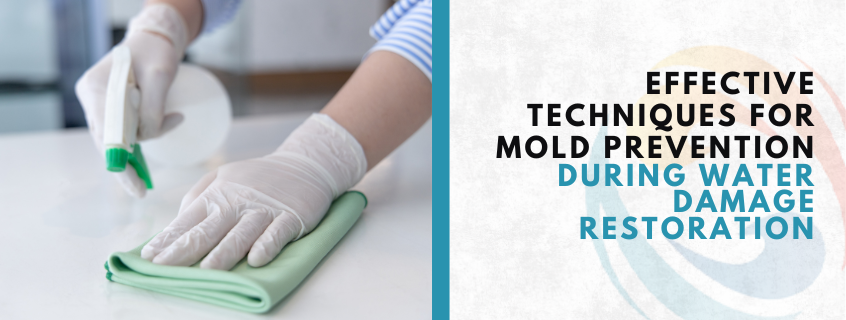
Water damage is one of the most distressing situations a homeowner can face. Picture walking into your home after a long day, only to find a burst pipe flooding your living room. Beyond the soaked carpet and waterlogged furniture lies a hidden threat—mold. It thrives silently in moisture-laden environments, potentially causing significant damage and health issues. Knowing the right techniques for mold prevention can mean the difference between a quick fix and a costly, long-term nightmare.
This guide will equip you with the most effective, practical, and proven strategies to prevent mold growth after water damage. Whether you’re facing minor leaks or a major flood, implementing these techniques for mold prevention ensures your home stays safe, healthy, and mold-free.
Understanding the Hidden Dangers of Mold
Mold isn’t just unsightly—it’s dangerous. It grows rapidly in damp environments and releases spores that can cause allergies, respiratory problems, and even long-term health complications. When water damage strikes, mold growth can begin within just 24–48 hours. That’s why swift action is essential.
Why Mold Thrives After Water Damage
- Moisture is the Catalyst: Mold spores are always present in the air but need moisture to grow.
- Porous Surfaces are Vulnerable: Carpets, drywall, and wood can absorb water and harbor mold.
- Poor Ventilation: Lack of airflow exacerbates humidity, creating the perfect storm for mold development.
🡆 Spotting the early signs is one of the most proactive techniques for mold prevention.
Rapid Response: The First Line of Defense
When water damage occurs, the first 24–48 hours are critical. A quick and coordinated response is one of the most essential techniques for mold prevention.
Emergency Steps to Take Immediately
- Extract Standing Water: Use a wet/dry vacuum or contact professionals to remove water as quickly as possible.
- Ventilate the Area: Open windows and run fans to circulate air.
- Lower Humidity Levels: Use dehumidifiers to reduce humidity to below 60%.
Pro Tip: Don’t underestimate the value of professional help. A certified team like this water restoration service in Agoura Hills offers emergency assistance that can prevent mold before it starts.
Comprehensive Damage Assessment
Before you begin any cleanup, you need to know exactly what you’re dealing with. A thorough inspection helps target potential mold hotspots.
What to Evaluate
- Walls and Flooring: Mold can hide behind baseboards and under floorboards.
- Furniture and Upholstery: Absorbent materials can retain moisture long after the surface dries.
- HVAC Systems: Moisture can travel through vents, spreading mold spores.
🡆 Use a moisture meter to identify hidden damp spots—one of the smartest techniques for mold prevention.
Sanitization and Surface Treatment
Cleaning is about more than appearances. Effective sanitization destroys mold spores and helps prevent regrowth.
Essential Cleaning Techniques
- Use Mold-Inhibiting Products: Specialized cleaners target mold at the root level.
- Bleach Solution for Hard Surfaces: Mix 1 cup of bleach per gallon of water for non-porous areas.
- Protect Yourself: Always wear gloves, goggles, and masks when using chemical agents.
Recommended Read: Learn more about trusted water damage restoration professionals who follow EPA-approved protocols.
Environmental Control: Mold’s Worst Enemy
Controlling your indoor climate is one of the most effective long-term techniques for mold prevention.
How to Maintain a Mold-Free Environment
- Keep Indoor Temperatures Cool: Ideal range is 68–72°F.
- Monitor Humidity Levels: Stay under 60%, ideally around 50%.
- Use Air Conditioners and Dehumidifiers: Especially in high-risk zones like basements or laundry rooms.
Location Tip: For property-specific evaluations and tailored solutions, check out this trusted restoration provider near you.
Sealing, Insulating, and Future-Proofing
Once your home is dry and sanitized, it’s time to think ahead. Preventing future water damage is another vital layer in mold prevention.
Best Practices for Long-Term Protection
- Seal Windows and Doors: Use caulk to close gaps and prevent moisture intrusion.
- Insulate Pipes: Avoid condensation, especially in cold areas.
- Install Vapor Barriers: Useful in crawl spaces and basements.
🡆 Future-proofing your property is one of the most overlooked techniques for mold prevention—and one of the most effective.
Long-Term Monitoring and Maintenance
Even after restoration, vigilance is necessary. Mold can return in as little as 24 hours under the right conditions.
Tools and Habits to Adopt
- Perform Regular Inspections: Especially in places prone to moisture—under sinks, near HVAC units, and in the attic.
- Install Leak Detectors: These can alert you to water issues before mold has a chance to grow.
- Use Smart Home Technology: Track humidity levels through your phone and receive alerts in real time.
Expert Resource: For advanced guidance and regular service checks, explore this leading water damage restoration provider.
Uncovering the Lesser-Known Techniques for Mold Prevention
In addition to traditional practices, there are lesser-known but highly effective techniques for mold prevention you should consider.
Unique Strategies Worth Exploring
- Eco-Friendly Mold Inhibitors: Natural solutions like tea tree oil and vinegar can work wonders.
- UV Light Technology: UV lamps in HVAC systems can kill mold spores.
- Mold-Resistant Building Materials: Use these during renovations, especially in bathrooms and kitchens.
Educating Yourself and Taking Initiative
Empowering yourself with knowledge is one of the strongest defenses against mold. Homeowners who understand mold behavior tend to respond faster and more effectively.
Know the Warning Signs
- Discoloration: Yellow, green, or black spots on walls or ceilings.
- Musty Odors: A telltale sign that mold is growing behind walls or under flooring.
- Allergic Reactions: Persistent sneezing, coughing, or asthma flare-ups could be mold-related.
When to Call the Experts
- Mold covering an area larger than 10 square feet
- Structural damage or recurring water leaks
- Health issues among household members
🡆 Need expert evaluation? Get a personalized consultation from 770 Water Damage & Restoration to learn how professionals use tailored techniques for mold prevention.
Why Choose 770 Water Damage & Restoration
When disaster strikes, having a reliable partner can ease the burden significantly. At 770 Water Damage & Restoration, you get more than just cleanup—you receive comprehensive support built on expertise and compassion.
What Sets Them Apart
- Rapid Emergency Response: Available 24/7 with industry-certified technicians
- Custom Mold Prevention Plans: Tailored to your home’s specific vulnerabilities
- Transparent Pricing and Service: No hidden costs, just dependable help when you need it most
Conclusion: Stay Ahead with Proven Techniques for Mold Prevention
Preventing mold after water damage is not a one-time fix—it’s an ongoing commitment to the health of your home and family. From acting quickly to implementing climate control and ongoing monitoring, the techniques for mold prevention you adopt today will protect your investment for years to come.
Be proactive. Stay informed. And when in doubt, don’t hesitate to reach out to experienced professionals who can help safeguard your home from mold’s hidden dangers.
Concise FAQs about Mold Prevention During Water Damage Restoration
Immediately turn off the electricity, remove standing water, and dry the area with fans and dehumidifiers. For professional assistance, contact 770 Water Damage & Restoration.
Thoroughly clean and sanitize affected areas, ensuring all moisture is removed. Regular inspections can help catch hidden dampness. Trust 770 Water Damage & Restoration for expert support.
For small areas, DIY cleanup is possible, but extensive mold growth requires professional help. 770 Water Damage & Restoration specializes in safe and effective mold remediation.
Use antifungal agents and specialized mold removers. 770 Water Damage & Restoration employs top-quality products to ensure your home stays mold-free.
Look for musty odors, visible mold, and high humidity levels. For thorough assessments, rely on 770 Water Damage & Restoration to help prevent mold after water damage.


